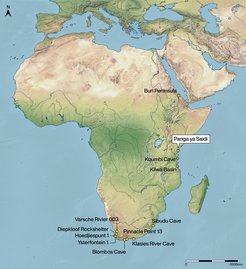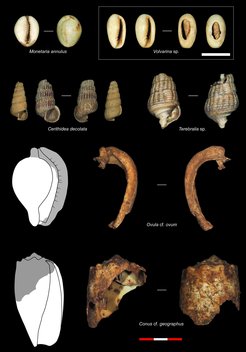67,000 Years of Coastal Resource Engagement at Panga ya Saidi, Kenya
A new study, published in PLOS ONE, reports the first long-term evidence for coastal engagement in eastern Africa

Understanding how people engaged with coastal habitats and marine resources is an important issue in Palaeolithic archaeology. However, most African sites with marine resources are found at the northern and southern extremes of the continent, and show only short pulses of occupation. Huge portions of the continent’s coast remain understudied, leaving significant gaps in our understanding of how early humans living along the African coast adapted to their environment. Now, a joint project led by researchers at the Max Planck Institute for the Science of Human History and the National Museums of Kenya has uncovered new data that provides a first look at coastal resource engagement in eastern Africa.
Panga ya Saidi (PYS) is a limestone cave complex located 15 km from the modern Kenyan coast, which recently made headlines for containing the earliest known human burial in Africa (https://www.shh.mpg.de/1989173/boivin-petraglia-oldest-burial-in-africa?c=1935799). But, the cave still has more to offer, as researchers have now identified the continent’s longest sequence of coastal resource engagement.
Archaeologists studied shells from a 3.5-meter-deep excavation to document patterns in the way people living at PYS acquired, transported, and even discarded coastal resources. Analyses reveal consistent pulses of coastal engagement over 67,000 years, but with distinct variations that show an evolving relationship with aquatic resources through time.

The oldest coastal resources at PYS suggest that people interacted with the sea only sporadically, collecting resources mainly for aesthetic or symbolic value. A tell-tale example is a Conus cf. geographus shell recovered from Layer 15 dating from 67,000-62,000 years ago. This species is a carnivorous snail with venom powerful enough to be fatal to humans. The toxin can be neutralized by cooking, however there are no signs of heating on the shell, suggesting it was not collected as a food resource. Symbolic marine shell use peaks between 48,000-33,000 years ago, with groupings of naturally perforated Conidae spires that had been systematically collected and transported together, likely for use as beads. Advances in social technology may suggest that growing populations and/or increases in inter-group contact encouraged people to create new modes of visual symbolism.
In the upper excavation layers, marine resources shift towards edible species, suggesting more consistent contact with the ocean. Layers dating from 14,000 – 8,000 years ago are dominated by marine taxa from intertidal or shallow subtidal rocky areas, while layers younger than this have higher percentages of upper intertidal, freshwater, and mangrove dwelling species. Many of these specimens (including rock oysters and mangrove snails) can stay alive for several days after collection. This makes them suitable for a delayed consumption strategy. Overall, molluscs make up only a small percentage of the food resources evident from PYS, but suggest that people there had regular access to the sea as part of a broad subsistence base.

The 67,000 year-long history of marine engagement at PYS is a unique opportunity to study the development of interactions between our ancestors and the sea. PYS is not only the oldest stratified archaeological site with coastal resources in eastern Africa, but it is also the only site on the continent with marine engagement from MIS 4 through 1. Crucially, the PYS record hints that eastern African coastlines could yield further evidence for early coastal resource engagement, similar to that from South Africa. Analysis of the molluscs at Panga ya Saidi provides the continent’s first long-term socio-economic sequence of coastal resources, and permits a first glimpse into the timing, nature and trajectory of marine resource engagement in eastern Africa.


